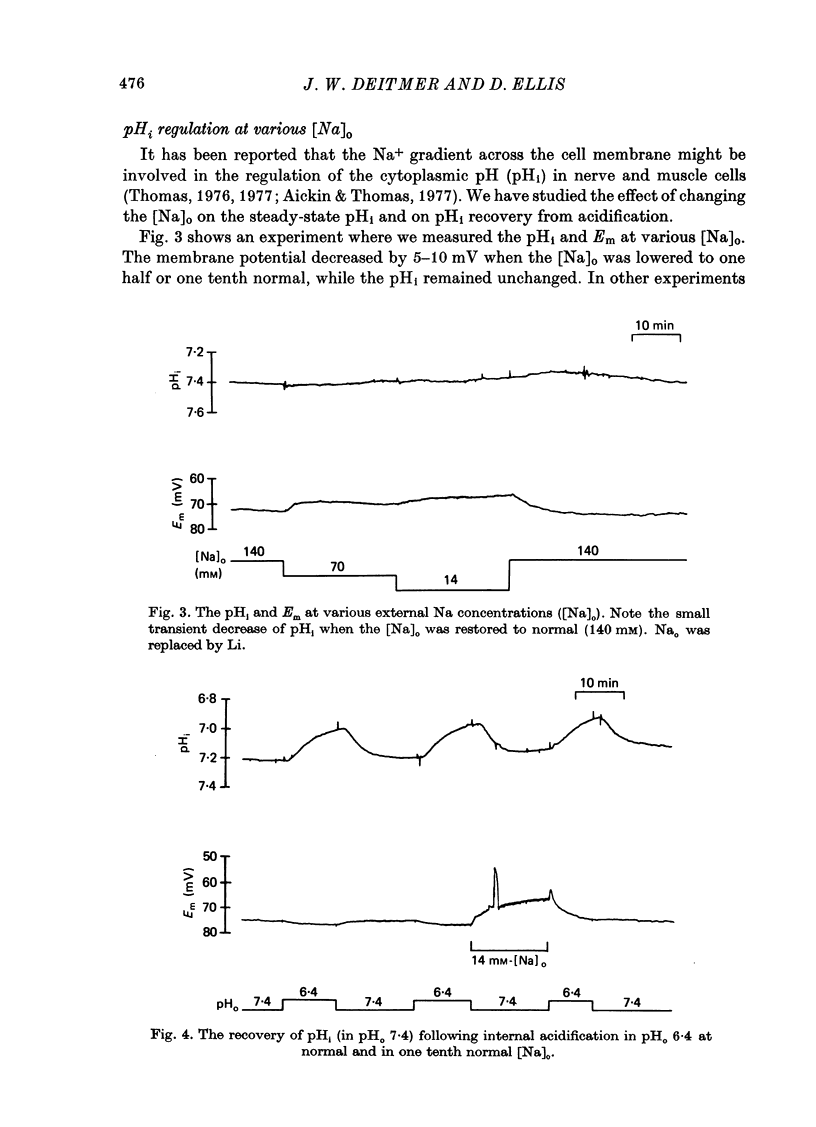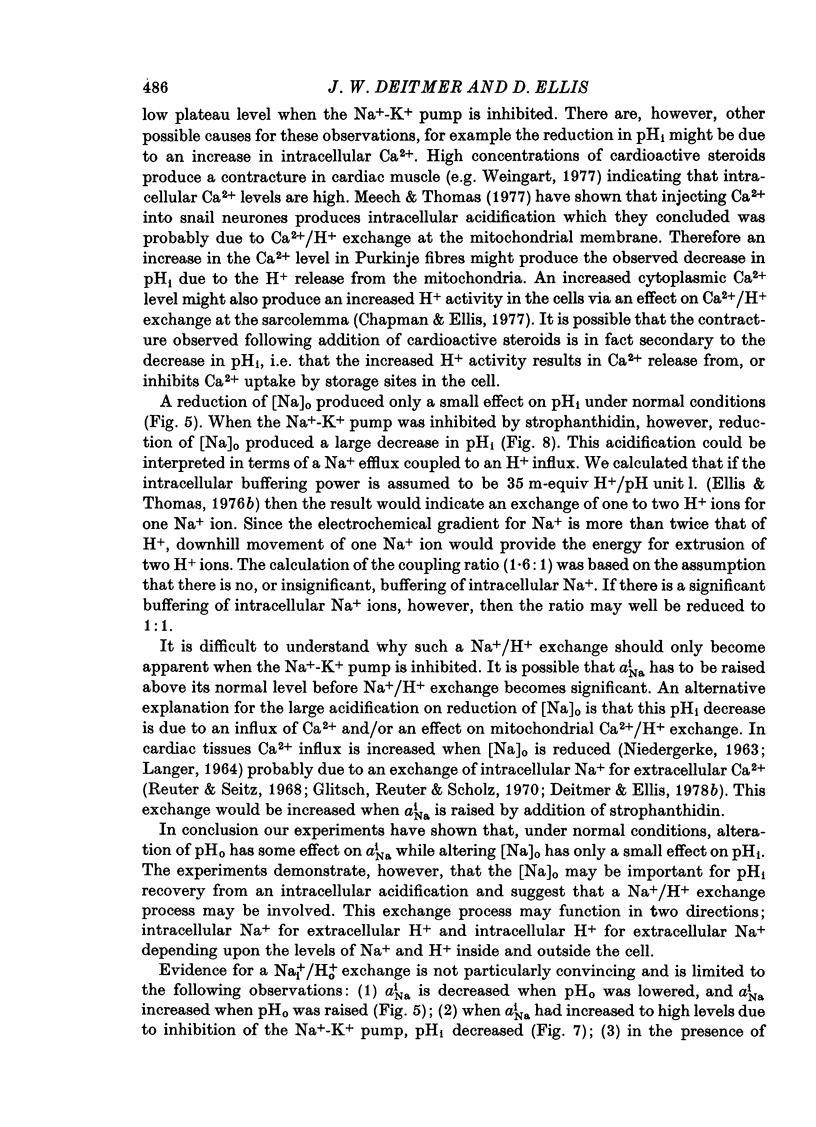Abstract
1. We have investigated the influence of the H+ and Na+ gradients across the cell membrane on the regulation of the intracellular pH (pHi) and of the intracellular Na activity (aNai) in sheep heart Purkinje fibres, using Na+- and pH-sensitive microelectrodes. 2. In oxygenated, nominally bicarbonate-free solutions (buffered with HEPES) the steady-state pHi changed linearly with the extracellular pH (pHo) by 0.23 pH units/pHo unit change over the pHo range of 5.4-8.4. The H+ equilibrium potential changed by about 47 mV/pHo unit change. 3. Both the steady-state pHi and the pHi recovery from acidification induced by lowering the pHo to 6.4 were affected only to a small extent by reducing the extracellular Na concentration [Na]o, to one half or to one tenth normal. 4. The steady-state aNai decreased by 5 to 20% when the pHo was reduced to 6.4 and increased by 3 to 8% when the pHo was raised to 8.4. These changes in aNai were still present when the Na-K pump had been inhibited by the cardioactive steroid strophanthidin (10(-5) M). 5. Exposure to K-free solutions caused an increase in aNai. Following addition of 6 mM-K (to re-activate the Na-K pump) the rate of decrease of aNai was not affected by pHo changes from 6.4 to 8.4. 6. Inhibition of the Na+-K+ pump by strophanthidin (10(-5) M) caused aNai to rise rapidly within 2-3 min. The pHi remained unchanged for the first 1-30 min after the pump inhibition, but then decreased by several tenths of a pH unit. 7. Amiloride (10(-3) M) caused a small decrease in a Nai and an intracellular acidification of up to 0.2 pH units. 8. Under conditions, where aNai was high due to inhibition of the Na-K pump by strophanthidin, lowering the [Na]o to one tenth normal produced a very large intracellular acidification, while aNai decreased. Amiloride increased this intracellular acidification even more, while the decrease in aNai remained unaffected. 9. Application of NH4Cl (20 mM) produced a decrease of aNai and a rapid intracellular alkalinization, followed by a slower acidification. Upon removal of NH4Cl the pHi dropped by several tenths of a pH unit but rapidly recovered. During this pH recovery there was a small transient increase in aNai above the control level before returning to normal. 10. The pHi recovery after the removal of NH4Cl was slowed by lowering the [Na]o to one tenth normal, and it was greatly inhibited in the presence of amiloride. The transient overshoot of aNai after NH4Cl removal was suppressed by amiloride. 11. We conclude that under some conditions there appears to be an exchange of intracellular H+ for extracellular Na+ across the cell membrane and that this exchange can help regulate the intracellular pH.
Full text
PDF

















Selected References
These references are in PubMed. This may not be the complete list of references from this article.
- Aickin C. C., Thomas R. C. An investigation of the ionic mechanism of intracellular pH regulation in mouse soleus muscle fibres. J Physiol. 1977 Dec;273(1):295–316. doi: 10.1113/jphysiol.1977.sp012095. [DOI] [PMC free article] [PubMed] [Google Scholar]
- Bentley P. J. Amiloride: a potent inhibitor of sodium transport across the toad bladder. J Physiol. 1968 Mar;195(2):317–330. doi: 10.1113/jphysiol.1968.sp008460. [DOI] [PMC free article] [PubMed] [Google Scholar]
- Boron W. F., De Weer P. Intracellular pH transients in squid giant axons caused by CO2, NH3, and metabolic inhibitors. J Gen Physiol. 1976 Jan;67(1):91–112. doi: 10.1085/jgp.67.1.91. [DOI] [PMC free article] [PubMed] [Google Scholar]
- Bull M. B., Laragh J. H. Amiloride. A potassium-sparing natriuretic agent. Circulation. 1968 Jan;37(1):45–53. doi: 10.1161/01.cir.37.1.45. [DOI] [PubMed] [Google Scholar]
- Carvalho A. P., Leo B. Effects of ATP on the interaction of Ca++, Mg++, and K+ with fragmented sarcoplasmic reticulum isolated from rabbit skeletal muscle. J Gen Physiol. 1967 May;50(5):1327–1352. doi: 10.1085/jgp.50.5.1327. [DOI] [PMC free article] [PubMed] [Google Scholar]
- Chapman R. A., Ellis D. The existence of a Ca2+ for H+ exchange across the sarcolemma of frog cardiac muscle cells [proceedings]. J Physiol. 1977 Feb;265(1):19P–20P. [PubMed] [Google Scholar]
- Chapman R. A. Excitation-contraction coupling in cardiac muscle. Prog Biophys Mol Biol. 1979;35(1):1–52. doi: 10.1016/0079-6107(80)90002-4. [DOI] [PubMed] [Google Scholar]
- Cingolani H. E., Mattiazzi A. R., Blesa E. S., Gonzalez N. C. Contractility in isolated mammalian heart muscle after acid-base changes. Circ Res. 1970 Mar;26(3):269–278. doi: 10.1161/01.res.26.3.269. [DOI] [PubMed] [Google Scholar]
- Deitmer J. W., Ellis D. Changes in the intracellular sodium activity of sheep heart Purkinje fibres produced by calcium and other divalent cations. J Physiol. 1978 Apr;277:437–453. doi: 10.1113/jphysiol.1978.sp012283. [DOI] [PMC free article] [PubMed] [Google Scholar]
- Deitmer J. W., Ellis D. Is there a link between in regulation of intracellular sodium and intracellular pH in mammalian cardiac tissue? [proceedings]. J Physiol. 1978 Nov;284:70P–71P. [PubMed] [Google Scholar]
- Deitmer J. W., Ellis D. The intracellular sodium activity of cardiac Purkinje fibres during inhibition and re-activation of the Na-K pump. J Physiol. 1978 Nov;284:241–259. doi: 10.1113/jphysiol.1978.sp012539. [DOI] [PMC free article] [PubMed] [Google Scholar]
- Ellis D., Deitmer J. W. The relationship between the intra- and extracellular sodium activity of sheep heart Purkinje fibres during inhibition of the Na-K pump. Pflugers Arch. 1978 Nov 30;377(3):209–215. doi: 10.1007/BF00584274. [DOI] [PubMed] [Google Scholar]
- Ellis D. The effects of external cations and ouabain on the intracellular sodium activity of sheep heart Purkinje fibres. J Physiol. 1977 Dec;273(1):211–240. doi: 10.1113/jphysiol.1977.sp012090. [DOI] [PMC free article] [PubMed] [Google Scholar]
- Ellis D., Thomas R. C. Direct measurement of the intracellular pH of mammalian cardiac muscle. J Physiol. 1976 Nov;262(3):755–771. doi: 10.1113/jphysiol.1976.sp011619. [DOI] [PMC free article] [PubMed] [Google Scholar]
- Ellis D., Thomas R. C. Microelectrode measurement of the intracellular pH of mammalian heart cells. Nature. 1976 Jul 15;262(5565):224–225. doi: 10.1038/262224a0. [DOI] [PubMed] [Google Scholar]
- Fabiato A., Fabiato F. Effects of pH on the myofilaments and the sarcoplasmic reticulum of skinned cells from cardiace and skeletal muscles. J Physiol. 1978 Mar;276:233–255. doi: 10.1113/jphysiol.1978.sp012231. [DOI] [PMC free article] [PubMed] [Google Scholar]
- Glitsch H. G., Reuter H., Scholz H. The effect of the internal sodium concentration on calcium fluxes in isolated guinea-pig auricles. J Physiol. 1970 Jul;209(1):25–43. doi: 10.1113/jphysiol.1970.sp009153. [DOI] [PMC free article] [PubMed] [Google Scholar]
- Horowitz S. B., Paine P. L. Reference phase analysis of free and bound intracellular solutes. II. Isothermal and isotopic studies of cytoplasmic sodium, potassium, and water. Biophys J. 1979 Jan;25(1):45–62. doi: 10.1016/S0006-3495(79)85277-7. [DOI] [PMC free article] [PubMed] [Google Scholar]
- LANGER G. A. KINETIC STUDIES OF CALCIUM DISTRIBUTION IN VENTRICULAR MUSCLE OF THE DOG. Circ Res. 1964 Nov;15:393–405. doi: 10.1161/01.res.15.5.393. [DOI] [PubMed] [Google Scholar]
- LUTTGAU H. C., NIEDERGERKE R. The antagonism between Ca and Na ions on the frog's heart. J Physiol. 1958 Oct 31;143(3):486–505. doi: 10.1113/jphysiol.1958.sp006073. [DOI] [PMC free article] [PubMed] [Google Scholar]
- Meech R. W., Thomas R. C. The effect of calcium injection on the intracellular sodium and pH of snail neurones. J Physiol. 1977 Mar;265(3):867–879. doi: 10.1113/jphysiol.1977.sp011749. [DOI] [PMC free article] [PubMed] [Google Scholar]
- NIEDERGERKE R. MOVEMENTS OF CA IN FROG HEART VENTRICLES AT REST AND DURING CONTRACTURES. J Physiol. 1963 Jul;167:515–550. doi: 10.1113/jphysiol.1963.sp007166. [DOI] [PMC free article] [PubMed] [Google Scholar]
- Orkand R. K. Facilitation of heart muscle contraction and its dependence on external calcium and sodium. J Physiol. 1968 May;196(2):311–325. doi: 10.1113/jphysiol.1968.sp008509. [DOI] [PMC free article] [PubMed] [Google Scholar]
- Reuter H. Exchange of calcium ions in the mammalian myocardium. Mechanisms and physiological significance. Circ Res. 1974 May;34(5):599–605. doi: 10.1161/01.res.34.5.599. [DOI] [PubMed] [Google Scholar]
- Reuter H., Seitz N. The dependence of calcium efflux from cardiac muscle on temperature and external ion composition. J Physiol. 1968 Mar;195(2):451–470. doi: 10.1113/jphysiol.1968.sp008467. [DOI] [PMC free article] [PubMed] [Google Scholar]
- Schwartz A., Lindenmayer G. E., Allen J. C. The sodium-potassium adenosine triphosphatase: pharmacological, physiological and biochemical aspects. Pharmacol Rev. 1975 Mar;27(01):3–134. [PubMed] [Google Scholar]
- Steenbergen C., Deleeuw G., Rich T., Williamson J. R. Effects of acidosis and ischemia on contractility and intracellular pH of rat heart. Circ Res. 1977 Dec;41(6):849–858. doi: 10.1161/01.res.41.6.849. [DOI] [PubMed] [Google Scholar]
- Thomas R. C. Intracellular pH of snail neurones measured with a new pH-sensitive glass mirco-electrode. J Physiol. 1974 Apr;238(1):159–180. doi: 10.1113/jphysiol.1974.sp010516. [DOI] [PMC free article] [PubMed] [Google Scholar]
- Thomas R. C. Ionic mechanism of the H+ pump in a snail neurone. Nature. 1976 Jul 1;262(5563):54–55. doi: 10.1038/262054a0. [DOI] [PubMed] [Google Scholar]
- Thomas R. C. New design for sodium-sensitive glass micro-electrode. J Physiol. 1970 Sep;210(2):82P–83P. [PubMed] [Google Scholar]
- Thomas R. C. The role of bicarbonate, chloride and sodium ions in the regulation of intracellular pH in snail neurones. J Physiol. 1977 Dec;273(1):317–338. doi: 10.1113/jphysiol.1977.sp012096. [DOI] [PMC free article] [PubMed] [Google Scholar]
- Vaughan-Jones R. D. Regulation of chloride in quiescent sheep-heart Purkinje fibres studied using intracellular chloride and pH-sensitive micro-electrodes. J Physiol. 1979 Oct;295:111–137. doi: 10.1113/jphysiol.1979.sp012957. [DOI] [PMC free article] [PubMed] [Google Scholar]
- Weingart R. The actions of ouabain on intercellular coupling and conduction velocity in mammalian ventricular muscle. J Physiol. 1977 Jan;264(2):341–365. doi: 10.1113/jphysiol.1977.sp011672. [DOI] [PMC free article] [PubMed] [Google Scholar]
- Williamson J. R., Safer B., Rich T., Schaffer S., Kobayashi K. Effects of acidosis on myocardial contractility and metabolism. Acta Med Scand Suppl. 1976;587:95–112. doi: 10.1111/j.0954-6820.1976.tb05871.x. [DOI] [PubMed] [Google Scholar]
- Williamson J. R., Woodrow M. L., Scarpa A. Calcium binding to cardiac sarcolemma. Recent Adv Stud Cardiac Struct Metab. 1975;5:61–71. [PubMed] [Google Scholar]


